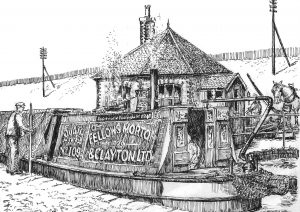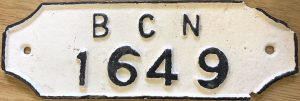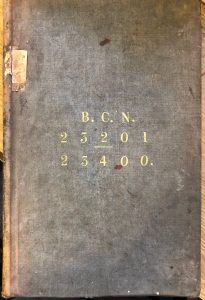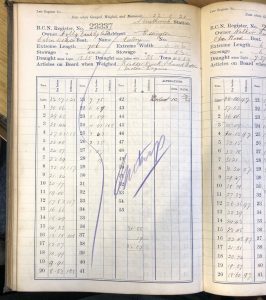The Birmingham Canal Navigations built, managed, and provided the waterways, a seriously expensive business. They financed the network by charging tolls for boats using the canals, like the M6 Toll, the Dartford Crossing, or the Humber Bridge.
The toll for using their canals was based on the weight of the cargo, and also the type of cargo being carried. The various acts of Parliament authorised the BCN to raise the tolls and the rates that could be charged.
When a boat was loaded, the master would be provided with consignment documents giving details of the load and type of cargo and its destination. In theory these could have been used for calculating the toll, and it is likely that initially this may have been the method used, although boats could be unloaded and the cargo weighed if the canal company insisted.
However, a system like this was open to abuse and fraud, and in 1835 the BCN obtained powers to gauge boats. An indexing station was provided on the new island line at Smethwick. This is the island that still survives, adjacent to the Engine Arm aqueduct.
In 1872, in order to ensure all boats were gauged, and to provide an additional location where this could be carried out, a further station was provided at Tipton, adjacent to Factory top lock. At that time a new register of boats was started. This is the system that carried on until gauging and toll collection was abandoned in 1959.
The gauge was calculated by filling the boat with one ton weights and measuring the free board or dry inches’. These measurements were taken at four places and an average calculated. Each boat was then fixed with two gauging plates, usually one each side inside the fore end and stern.
Four smaller plates where fixed to the gun-whale where the gauge had been taken. A register entry was then completed for each boat.
To oversee the system, a series of Toll Offices where provided, where the boats could be checked. Under the system, established in 1872, each office was provided with a set of registers from the details compiled by the gauging station and against which the toll clerk could ‘gauge’ the boat and calculate the load from the measurements.
The cost of the toll was calculated based on the distance, weight of load and type of cargo and toll ticket was then issued at the first office that the boat passed and this was checked at subsequent offices along the route. Tolls were collected in cash or by account.
The boats carried two plates with a unique BCN registration numbers. They were usually riveted on the inside, at the bow and stern ends, and on diagonal sides, so one of them would be visible from either side of the boat.

©Will King Collection.
LMS boat for Brierley Hill, Dec 1955. C Clark and J Smith boatmen, Tividale, with TW King gauging the railway boat at the Netherton Tunnel toll office.
Every time a loaded boat passed a toll station, the weight of the load was calculated, based on the measured draught, and the information about the draught of an empty boat. The results were entered into big books like the one shown here.
HELENA is described as a cabin wood boat, that is it has a wooden hull and a cabin. Although, in this case, no doubt a short BCN style cabin, rather than the larger cabins on the long distance trading boats. The alternative descriptions would be "open iron", "open wood" or "cabin iron". "Open" in that it has no cabin, and iron being the material used for the hull. Later, when motor boats came into use, the term "motor" was added to the description.
The overall length of the boat was 71'4", with a beam of 7'1 1/2". The internal dimensions of the hold was 58'5", with a width of 6'9". Deducting the hold length from the overall length can give a good indication of the type of cabin on the boat.
Whilst the boat was empty when gauged, it did have 5 beams, rudder and mast aboard. If these were missing, when the boat was in traffic it, would affect the gauge. Often other items are recorded.
The sheet has been endorsed that Spencer Abbot became the boats owners, late of Elements. The sheet has been struck through and the boat cut up.
The table then shows the free board for each one ton weight increment. It was against these that the toll office clerk was able to calculate the load. It is likely that the heavier weights in the table were calculated rather than from actual measurement.
Whilst the BCN kept registers for all boats, they would also supply a copy of an individual gauging register to boat owners for a fee."
A BCNS member has transcribed all the information from those books into the database below. The entry for HELENA, mentioned above, is
The database can be searched by boat number, boat name, boat owner, and year.
The table by clicking on any of the headers. To revert the sort order, click on the same header again.
Further reading:
"Gauging Boats on the BCN" by Ray Shill, NarrowBoat, Summer 2007
"Getting the Gauge" by Christopher M. Jones, NarrowBoat, Summer 2010














Comments 9
Hello, I have came across a bcn plaque I am wondering if you can tell me the name of the boat it was on please
BCN 1515
Thank you
Apologies for the delay in replying – I have only just seen your query.
BCN1515 was registered at Tipton Gauging Station on 31 July 1929 (ref 1515) and had the name Beck 17 at registration. It was registered as being owned by the LMS Railway Co, based in Wolverhampton. It was a 70′ long,open,iron narrow boat.
Hope this helps you
Phil Wild (BCNS Archivist)
I am looking for information on BCN10481 Boat Martha but not able to find it. Can you suggest where I may find this info. My GGgrandfather’s other boat BCN12002 is there. Where would I be able to see the full page entry regarding this boat? Can you also tell me the date of the photo you use at the start of this page as it shows Boat George which is the name of BCN12002. Both boats would have been out of Worcester.
Regards
Vanessa Williams
Unfortunately there are quite a number of B.C.N. Gauge Registers missing, particularly those pre-1895 when the B.C.N. Company started a process of re-gauging boats still working across their waterways and disposing of old tables. This process was completed in 1906 where the first 14000 gaugings were condensed down to 1629 to cover those boats still trading but not re-gauged. BCN10481 is one of the tables that was removed during this purge, so at present I have no details. There were numerous versions created of each B.C.N. Gauge Register as each Toll Office would have its own copies, and although many have been destroyed their are still quite a few that exist. The B.C.N. Society has a copy of BCN12002 as does the Canal and River Trust archive at Ellesmere Port. I have a digital image of this table which shows BCN12002 to be a conventional horse boat with normal running gear and tarpaulins.
It is highly likely that MARTHA and GEORGE were health registered under the Canal Boat Act 1877 at Worcester, but once again much of this Register is missing so finding the relevant informatic will be challenging.
The photograph at the top of this page shows the day boat GEORGE at the top of Factory Locks, Tipton, and the building alongside the lock is Tipton Gauge Station which last weighed a boat on 05 April 1962. As both of the arches are bricked up this photograph must post date the last weighing, and I can assure you that the GEORGE in this photograph is a different boat to the on operated by your family.
The opinions and research mentioned by me in this reply are mine and not those of the B.C.N. Society.
Vanessa, how do you know the picturer at the start of this site is of George BCN No 12002, as in total there were at least 30 boats named Gorge and the boat in the picture could be any one of them!
Hi there. How extensive is your database? I’m putting in the BCN number from a boat and getting no results. Are later books missing?
All of the B.C.N. Gauge Registers post 01 January 1895 / BCN13930 still exist and should appear in the database on this page. B.C.N. Gauge Registers prior to this date are very much hit and miss due to a purge carried out by the B.C.N. Company, with only 1629 readily available tables existing with a few more in other collections. What B.C.N. gauge number are you interested in as I have quite a lot more information ?
The opinions and research mentioned by me in this reply are mine and not those of the B.C.N. Society.
Your searchable BCN Gauging Register database is self deleting when I try to access it on this site. Can you please get it up a running as soon as possible please?
Author
Thanks for the information! The manufacturer of the database plugin is working on an urgent fix for the probklem.